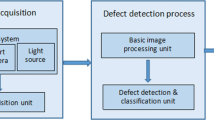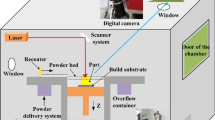Abstract
In this research, the automatic optical detection system is developed for detecting the sectional profile and the surface of the thin-film transistor liquid crystal display (TFT-LCD) panels after being treated through the cutting process. Traditional image processing inspection relying on pre-determined thresholding cannot achieve ideal results in slight defects in glass substrates. The proposed image pre-processing process was integrated with the deep learning technique to further enhance the detection process of inconspicuous defects in glass substrates. In addition, the photoelastic reflection lighting technique was used to highlight subtle defects in low-contrast surface images of glass substrates. When tested with the sectional profile photodetector, uniformed lighting effect is achieved by combining the concentrated light source of the inner coaxial lens with the line light source in order to test the surface coarseness-related characteristics of the glass sectional profile so as to indicate the defect while intensifying the contrast effect of the sectional profile background. When detecting the sectional profile features, it is conducted by separating the rib mark features through the U-Net network model developed for the deep learning; in result, 100% accuracy can be achieved. When detecting the sectional profile defect, Auto Encoder network model of the deep learning is used to learn the background picture retrieved from the original picture through the linear regression process. As a next step, the model is used again to predict the result by subtracting the background picture from the original picture, and then the defect position is highlighted; as a result, 98% accuracy is achieved. When detecting the model acceleration, it is conducted by revising the model weighting data format. In terms of U-Net Model, the reading time has been shortened for 4.28 s; in individual picture, the prediction time has been shortened for 0.29 s; in Auto Encoder, the model reading time has been shortened for 19.23 s; and the individual picture prediction time has been shortened for 0.94 s. As for the surface detection, the circular polariscope is developed. During the detection, the photoelastic reflection theory is employed by projecting the circularly polarized light vertically onto the panel surface in order to produce the interfering halo at the deformed area surrounding the denting defect, and the resulting features are referenced to identify the denting defect. By screening the mean luminance value of the sliding window and the discrete value, 90% detection accuracy can be achieved. In the meantime, it can also be used to pinpoint the denting defect that is over 3° in average angle change as seen on the normal line surrounding the defect.































Similar content being viewed by others
Availability of data and materials
The datasets analyzed during the current article are available from corresponding author.
Code availability
Not applicable.
References
Abd Al Rahman M, Alireza Mousavi (2020) A review and analysis of automatic optical inspection and quality monitoring methods in electronics industry. IEEE Access 8:183192–183271
Fan MR (2008) Study of the characteristics of the light/thin LCD panel fabrication. Yuan Ze University, Master's Thesis
Wee Keong Neo, Dennis et al (2021) Edge grinding characteristics of display glass substrate. J Manuf Mater Process 5.1:20
Chen CC (2012) The product-mix decisions for LCD and EPD product in TFT LCD industry. Chiao Tung University, Master's Thesis
Zhong ZW, Tian YB, **e TG (2016) Investigation of subsurface damage of ground glass edges. Int J Adv Manuf Technol 87(9):3261–3269
Lin YT (2002) Development and exploration of line scan machine vision inspection systems. Master's Thesis, Chung Hua University
Lu R, Wu A, Zhang T, Wang Y (2018) Review on automated optical (visual) inspection and its applications in defect detection. ACTAOPTICASINICA 38(08):23–58
Imai K et al (2019) Dynamic observation of crack generation during wheel scribing from lateral and back sides using a high-speed camera. Precis Eng 60:421–427
Pan CT et al (2008) Study of cutting quality for TFT-LCD glass substrate. Int J Adv Manuf Technol
Ronneberger O, Fischer P, Brox T (2015) U-net: convolutional networks for biomedical image segmentation. in International Conference on Medical image computing and computer-assisted intervention, Springer, pp 234–241
Lin XC (2020) Comparing the segmentation performances between U-net and data density functional method in MRI datasets. National Central University, Master's Thesis
Jo H, Kim J (2019) Regularized auto-encoder-based separation of defects from backgrounds for inspecting display devices. Electronics 8(5):533
Xu K, Wang JQ, Liu XW (2017) Novel image feature extraction algorithm based on fusion AutoEncoder and CNN. Application Research of Computers 34(12):3839G3843
Vanhoucke V, Senior A, Mao MZ (2011) Improving the speed of neural networks on CPUs. Deep Learning and Unsupervised Feature Learning Workshop
Lawn BR, Swain MV (1975) Microfracture beneath point indentations in brittle solids. J Mater Sci 10(1):113–122
Shin D-C, Hawong J-S (2011) Development of a hybrid method of reflection photoelasticity for crack problems in anisotropic plates. Exp Mech 51(2):183–198
His-Chao Chen, Kuo-Ting Huang, Po-Wei Cheng (2017) Thin-film stress measurement technology development for optoelectronic components. Journal of Taiwan Vacuum Society 30(2)
Minami, Hirofumi et al (2011) Manufacturing and inspection equipment for efficient production of large LCDs. Hitachi Rev 60.5:228–232
Chi YC (2012) Optical properties of Cr, CrxOy, CrxNy thin films. Master's thesis, Chung Hsing University
Sárosi Z, Knapp W, Kunz A, Wegener K (2010) Evaluation of reflectivity of metal parts by a thermo-camera. InfraMation 2010 proceedings pp 475–486
Yang LH (2005) Machine vision-based light-on test for LCD panel. Chung Hua University, Master's thesis
Matthias S, Kästner M, Reithmeier E (2016) Comparison of LASER and LED illumination for fiber optic fringe projection. in Optical Sensing and Detection IV 9899:989905 International Society for Optics and Photonics
Chuang YC (2009) Study on inspection method for glass substrate’s surface scratch study on inspection method for glass substrate’s surface scratch study on inspection method for glass substrate’s scratch defects. National Kaohsiung University of Applied Science and Technology, Master's thesis
Chuang CI (2004) The study of a linear dichroism and retarder combined system by multi-wavelength photoelastic modulated ellipsometry. Jiaotong University, Master's thesis
Stokes GG (1851) On the composition and resolution of streams of polarized light from different sources. Trans Cambridge Philos Soc 9:399
Mueller H (1943) Memorandum on the polarization optics of the photoelastic shutter. Report of the OSRD project OEMsr-576 2
Zhang M, Yin L (2022) Solar cell surface defect detection based on improved YOLO v5. IEEE Access 10:80804–80815
Chen Y, Dai L (2016) Nature of crack-tip plastic zone in metallic glasses. Int J Plast 77:54–74
Hsu WC, Chang WC, Sun PL, Chang LW (2015) Electron backscatter diffraction study on early recrystallization of ultra-low carbon steel. Min Metall 59(3):59–68
Funding
This research was supported by the Ministry of Science and Technology, Taiwan, under Grant no. 110–2221-E-027 -079 -MY2.
Author information
Authors and Affiliations
Contributions
Chao-Ching Ho conceived and designed the experiments; Hao-** Wang performed the experiments; Chao-Ching Ho and Hao-** Wang analyzed the data; Yuan-Cheng Chiao and Hao-** Wang contributed deep learning implementations; Chao-Ching Ho wrote the paper.
Corresponding author
Ethics declarations
Ethical approval
This article does not contain any studies with human participants performed by any of the authors.
Consent to participate
Informed consent was obtained from all individual participants included in the study.
Consent for publication
The participant has consented to the submission of the case report to the journal.
Competing interests
The authors declare no competing interest.
Additional information
Publisher's Note
Springer Nature remains neutral with regard to jurisdictional claims in published maps and institutional affiliations.
Rights and permissions
Springer Nature or its licensor holds exclusive rights to this article under a publishing agreement with the author(s) or other rightsholder(s); author self-archiving of the accepted manuscript version of this article is solely governed by the terms of such publishing agreement and applicable law.
About this article
Cite this article
Ho, CC., Wang, HP. & Chiao, YC. Machine vision-based cutting process for LCD glass defect detection system. Int J Adv Manuf Technol 123, 1477–1498 (2022). https://doi.org/10.1007/s00170-022-10261-9
Received:
Accepted:
Published:
Issue Date:
DOI: https://doi.org/10.1007/s00170-022-10261-9




